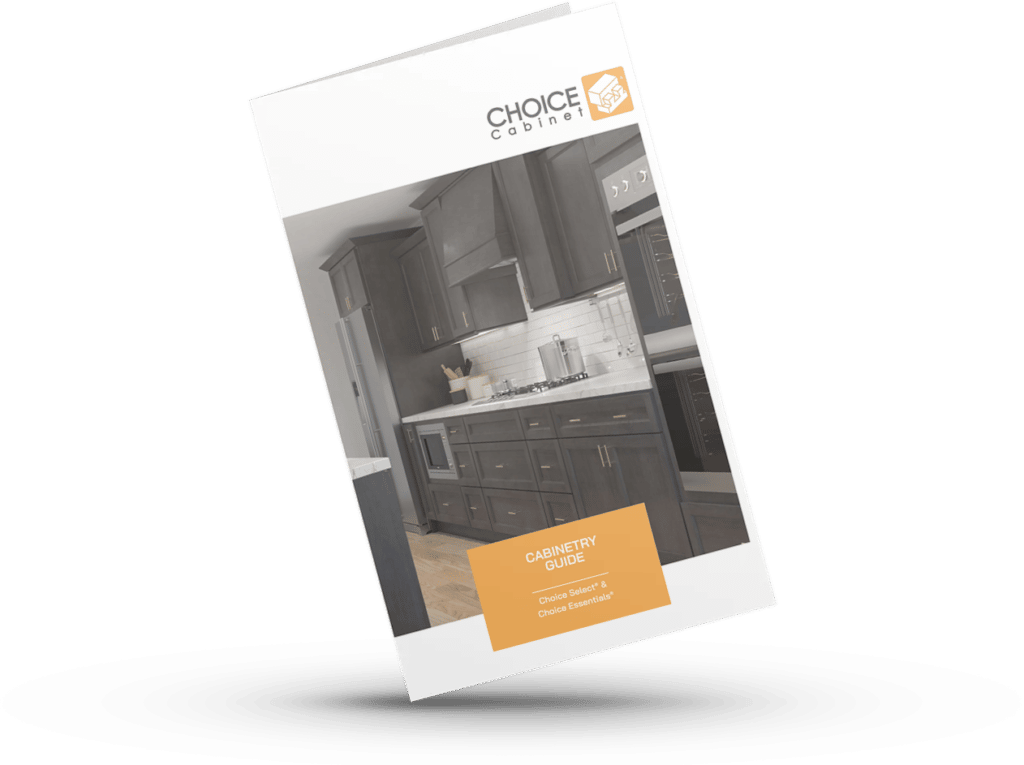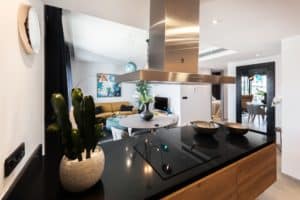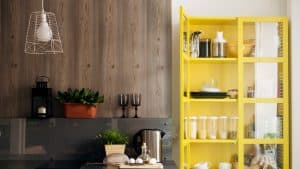Steel and plywood are available materials for cabinet doors and cabinet boxes. Solid wood is costly and does not have an attractive smooth texture. It requires extensive care. Plywood is a higher construction material since its nominal thickness doesn’t crack. As a result, it is a better option for plywood furniture. It is particular to modern furniture with bright colors and veneer core layers.
Plywood comprises several thin layers of wood fastened together. It is an excellent material for kitchen cabinets. Kitchen cabinets produced from plywood can withstand heavy crockery and other kitchen equipment. For more information, read on to find out how to identify the right plywood for cabinets.
How do you identify the best plywood for cabinets?
There are many different types of plywood in the market, each with its own needs. If you’re new to the furniture industry, the various terms might confuse you. You may also feel lost when selecting the right plywood for your project.
As a result, we are here to assist you with the procedures to take before buying a piece of fine furniture.
Before you go on, check out our extensive article on the best materials for kitchen cabinets in the USA
1. Lookout for flatness
It is critical to observe the flatness of the plywood, as non-flat plywoods are challenging to work on. So, we do not recommend you go for plywood that isn’t genuine. The reason is that it can cause a slew of safety and durability difficulties.
The plywood that is flatter performs better than the others. Although stumbling across one or two curved pieces of plywood is pretty uncommon. It is crucial to make every effort to avoid them. They are tough to use, especially on huge areas such as cabinet doors, floors, and rooftops. Furthermore, if the plywood is not at least 95% flat, its stacking has a problem. And this will lead to further issues.
See also: Particleboard or plywood cabinets, which is better for the kitchen
2. Edge inspection
When it comes to edges, we’re talking about piles and thickness of the hardwood cores. We measure them by looking at the plywood’s edges. Likewise, the general rule is that the thicker the plywood edges are, the better option. During sanding and polishing, thin veneered plywood will cause significant challenges. Again, if the holes and knots are visible within the veneer layers, it will increase all over the plywood.
The use of piles and thicker veneers gives perfect edges. These edges ensure that there are no voids or knots. The cabinet unit does not determine the structure and condition of the cabinet unit. That means if you use a pressed wooden panel face and back assessment, it will offer you a stunning design. The design will look polished on the inside and exterior surfaces, edges, and end boards. We use Euro Ply with its distinctive all-birch, multi-handle edge. The extra slight inward curves give the finished edges of the cabinet a unique style. There’s no need for edge band treatment, so the pressed wood edges will remain exposed.
3. Avoid birch, spine, and maple if you’re staining
Certain wood species are difficult to stain. Some become blotchy, creating an uneven tone, while others absorb stains. Birch does not react well to stains. It absorbs uneven pigments and leaves a splotchy finish, dark stains. Moreover, birch has a grain pattern like Cherry, Mahogany, and Walnut. So it’s a less expensive choice that may look more upscale with the correct stain color.
Pine has an uneven thick grain. It means that when you apply stains on it, it will waste time reaching the dense sections of the wood. But if you use a bright color, you can have a good stain from plywood. But, you should shun dark colors. Pine absorbs a lot of stain around knots and cracks, making dark stain colors plain.
Maple is hard and dense, so large pigment particles can not penetrate the wood very well. If you decide to stain maple, we recommend you hold on to light or medium stain colors and ignore the dark ones. You can use a polyurethane finish to prevent an uneven tone.
4. Understand the grading system
Plywood comes in various grades, which you have to select. This selection depends on the environment where you will make use of the plywood. The term cabinet grade plywood is a concept that applies to every softwood or hardwood plywood. Wood makers use plywood to construct cabinets or household furniture equipment. And only the correct grade can assure that there’ll be no need for edge band treatment. This applies to certain hardwoods like cherry species, red oak, and maple.
There are times when we see a plywood sheet labeled “bureau grade.” We do not notice the specific hardwood core veneers in cases like this. It refers to cheap hardwoods such as baltic birch plywood or several types of mahogany.
5. Always watch out for damage
Even though plywood is a solid manufactured material, it is not durable. It would be fantastic if it were, but that isn’t going to happen. Rather, we must watch out for damage when buying plywood. Also, prepare to restore damaged plywood, particularly when its key region is faulty. There are diverse kinds of damage that plywood might sustain, but we’re talking about scratches and blisters.
Water damage is the first to affect the plywood’s edges. When this happens, it calls for modification. Major damage such as a shattered piece of plywood sheets always necessitates replacement.
6. Inspect face veneers
The wood face veneer is important in the plywood manufacturing process. Every plywood must have a face veneer. A veneer is a term used to describe thin sheets of furniture or bark attached to core panels. They may be wood, particleboard, or medium-density fiberboard core. We use this veneer to create flat panels such as tops, doors, and panels for cabinets, and parquet floors. Three or more layers of veneer make-up plywood. Each is bonded with its grain at right angles to the next layers for strength.
The surface of the back veneer has beautiful color variations. Face veneer on plywood is like physical and mechanical qualities. For standard thicker plywood, the suggested thickness range is one-eighth inch. The actual thick face veneer helps to cover the appearance of resin on the plywood cores surface. It will result in a smooth surface and a more appealing appearance. Second, it bonds to a cross-section of veneer core. So it improves the mechanical qualities of plywood, which are linked to the product’s longevity. Face veneer cuts are either rotary cut or plain sliced veneer.
7. Choose to haul sheets yourself
If you choose to haul the sheets yourself, you’ll feel the weight of the hardwood plywood. And when you strike the middle of the plywood sheets, you’ll be able to tell if it’s hollow or not. If the construction plywood isn’t hollow, you’ll hear matching noises from all sides. Also, the four edges of the plywood must have thickness variations.
8. Go with an experienced friend
Sometimes, it’s better to go with someone who has ideas on the types of plywood available in the market. Let’s assume you’re looking for Marine plywood and aren’t sure what to expect in quality and style. The merchant may give you commercial plywood in the name of Marine plywood. Not only that, but he’d charge twice as much for standard plywood as he would for marine plywood. This is where you will feel duped.
So if you don’t go with a friend who has an eye for plywood, the seller may give you a wood that’ll decay faster. And you’ll have to spend more to buy a standard one and pay for installation.
Want to buy the best kitchen cabinets at wholesale prices? Check out how Choice Cabinet lets you save more and still get premium quality cabinets.
9. Avoid sub-grade core materials
Disregard plywood that has particleboard core and medium-density fiberboard (MDF layer). But, veneer core plywood is more durable than the MDF layer. Avoid sub-grade core materials. The reason is that wood makers get this material from wood wastes such as sawdust and wood chips. Medium-density fiberboard and particleboard core are standard for cabinet construction and furniture cabinetry. Yet, they are not fit for fastening sturdy seams and sustaining large. Thus, choose solid wood for kitchen cabinets with a laminated plywood core.
10. Look out for the curves
More buildings now have curved kitchen cabinets and bow-front cabinets. Bent plywood creates a smooth, cohesive effect in cabinetry and furniture. If your design demands curved edges, you’ll need some plywood cabinets with the right curve.
The ideal material has thinner plies enough to bend into the desired shape you yearn. Yet, it’s sturdy enough to go through extra manufacturing and gluing as the project demands. Moreover, you can bend plywood at your convenience in the home. You can do this with clamps, a medium-density fiberboard form, or a ratchet strap. The MDF produces a more stable panel. You may decide to bond more layers of plywood together. So the item you’re curving will become thicker for a stronger and durable bend. It’s crucial to give the plywood adequate time to curve, regardless of which technique you use.
Cabinet Grade Plywood to Consider
Below are the four main plywood cores to look out for when choosing the perfect cabinet-grade plywood. Note that the better the grade, the more expensive but the cost of the plywood should not be a source of worry if you want lasting results. Most of these may be the same species but the process of creation may differ.
Plywood Grade A
A- cabinet grade plywood is the highest quality because the veneers are perfect, which makes it the most costly. Grade plywood to have a smooth surface, knot-free surface, and can be painted. The number of plain sliced sheets glued together will determine the thickness of this A-grade plywood.
Plywood Grade B
B grade plywood is largely devoid of knots. However, some tight knots of less than 1 inch are permissible. B – grade plywood has a solid base and it’s a mildly less smooth surface than the A-cabinet grade plywood. It sometimes has minor defects that could be repaired.
Plywood Grade C
C-cabinet grade plywood does have a few knots up to 1.5 inches in diameter and knotholes under 1 inch in diameter in its sheets. C-cabinet grade plywood has a little poor quality.
Plywood Grade D
D-cabinet grade plywood is the cheapest plywood sheet and has a lower grade. Its basic defects are not corrected, so they’re a little bigger and more obvious. Knots and knotholes up to 2.5 inches in diameter are common in this grade of plywood.
The choice of panels to use for finishing are all those with an A or B stamp. Whether you want to finish both sides, ensure the two-letter grades are an A or a B. C-D grade plywood is suitable for internal decor use. You might come across an additional grade with an X at the end, such as A-CX. This indicates that the panel is manufactured with water-resistant glue and has met the requirements for exterior plywood.
This material may survive some moisture exposure, as the X indicates. CDX is often used in the construction of tabletop and storage containers. Plywood with a CDX rating has a C grade on one veneer and a D grade over the other and is intended for exterior plywood use.
Conclusion
Most plywood cabinets have a baltic birch plywood core with red oak or maple hardwood. Prepare to pay more if you want oak or maple plywood. Birch plywood with hardwood veneer is a good choice for most homeowners. Thanks to the plywood, the cabinet is stable, and the hardwood veneer is often unnoticeable from solid wood.
Want to get the best deals on plywood cabinets? Are you a reseller and want to make higher profits by selling the highest quality cabinets? Reach out to Choice Cabinet today and let us discuss how to help you make it happen






